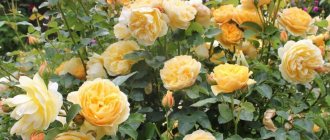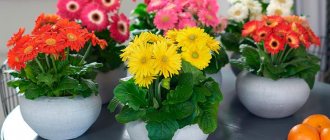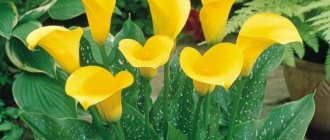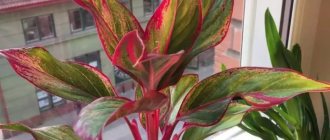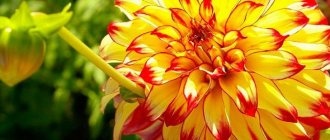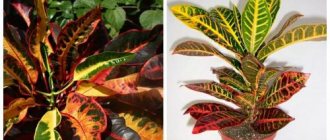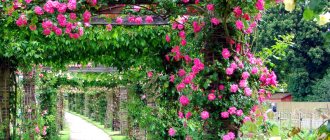Each of us tries to make our home more comfortable and cozy. Flowers add undeniable comfort to any apartment or house, and it is also useful, because indoor plants perform the function of purifying the air. Archaeological science, based on pollen found in caves, has proven that even in the Stone Age, people decorated their homes with flowers. Today, indoor floriculture is a separate science, and from all the variety of house plants, we present the most beautiful indoor flowers.
18 most beautiful types of indoor flowers:
1
Clivia
The beautiful evergreen plant is named after Duchess Charlotte Clive, who was governess to the future Queen Victoria of Great Britain.
This flower arrived in Europe from South Africa, easily took root in northern latitudes and became a favorite of most gardeners.
An unpretentious plant will decorate any home or office space, but you must try not to move the pot and water it once a week.
2
Indoor climbing plants (photos and names)
Multi-flowered jasmines (lat. jasminum polyanthum)
They are classified as liana plants. Jasmine blooms with white star flowers, 5 petals each. Attractive strong aroma. This plant will perfectly decorate the interior, as it is evergreen, and its climbing vines look very impressive.
Jasmine multiflorum
The pot is placed in bright sunlight and watered twice a week in winter, and once every 2-3 days in the warm season.
ADVICE!
Jasmine loves humid air and spraying!
Unlike many flowers, jasmine loves to be fed not during flowering, but after it for 6 months in a row.
The vine grows up to 2 m and grows for about 10 years in a greenhouse or glassed-in loggia. The apartment is decorated with jasmine for no longer than six months.
Crassula
The round leaves of this plant look like coins, which is why Crassula is often called “money tree” or “crassula” among gardeners.
When it blooms, it is covered with small white flowers, sometimes red, and very, very rarely the flowers can be blue.
One of the most unpretentious room dwellers. Even a leaf that falls to the ground can sprout into a separate plant.
3
Lithops
Photo credit: Dornenwolf / flicr
Translated from ancient Greek, the name of the plant translates as “stone appearance,” perhaps because it comes from the rocky and sandy deserts of Namibia and Botswana.
That is why Lithops has learned to retain moisture and easily tolerate heat and arid climates.
The flowers of the desert dweller who migrated to apartments are white or yellow; very rarely there are varieties with orange petals.
4
Croton
This species, growing in tropical and subtropical zones, has long become popular among flower growers around the world.
Its bright leaves will add variety and uniqueness to your home, or will become a real decoration for your office. Due to its shape it has become very popular among amateur gardeners.
The plant is easy to care for, and some of its species grow up to 80 centimeters in height.
5
Indoor poisonous plants (photos and names)
Before you buy any indoor plant, make some inquiries - what if your plant is poisonous, and despite its external beauty, you shouldn’t bring a potential threat to all inhabitants into the house?
Dieffenbachia
The advantages of the beautiful Dieffenbachia: tall growth, spreading burdock leaves with different color options, the ability to improve the quality of the air around it... but the plant juice is poisonous! If the integrity of the plant is damaged and the poison gets on the skin or mucous membranes, then gastrointestinal and respiratory problems are possible. If juice gets on your skin, burns may occur.
ATTENTION!
Caring for Dieffenbachia is carried out only with gloves!
Dieffenbachia
Dieffenbachia often grows as a spreading bush
Euphorbia
If a curious child picks the skin of a plant and sees white juice, so similar to milk, then the following consequences are possible: diarrhea, nausea, dizziness, serious burns of the mucous membrane.
The milkweeds themselves are varied in form and, of course, beautiful. However, such beauty is not worth the risk.
Spurge
Euphorbia is very similar to a cactus with leaves.
Aloe striped, Aloe intimidating
The medicinal form of aloe looks like poisonous ones, the difference lies in the color of the plants. Striped and frightening can cause miscarriage, uterine bleeding, and serious disturbances in the functioning of the stomach.
Aloe awesome
Bromeliad
They named the indoor flower and the entire genus in honor of the Swedish biologist Bromelius. This tropical beauty is a distant relative of the pineapple.
Their leaves are lancet-shaped, they are collected in a kind of rosette from which the peduncle grows. Bromeliads require watering only once a week, but bromeliads should be placed in places that receive sunlight.
Flowering lasts from 3 weeks to several months, delighting the owners and guests of the house.
6
Where to put
Decorative and flowering plants can decorate all rooms in the house. When choosing flowers, take into account the characteristics of the premises.
In the kitchen
Practical housewives grow plants in the kitchen that are suitable for cooking. On the kitchen windowsill you can grow peppers and tomatoes, lettuce and arugula, and herbs:
- mint;
- basil;
- rosemary;
- parsley;
- dill.
If you don't have much room for flowers in your kitchen, use hanging pots.
In the children's room
Indoor plants for a nursery should under no circumstances be poisonous. It is a good idea to grow plants with your children from shoots and seeds. Watering indoor plants can be entrusted to children. This will help develop a sense of responsibility in children.
Advice from an expert
Natalia Green
Plants with an antimicrobial effect that purify the air from harmful substances are suitable for children. These include chlorophytum, Kalanchoe, spathiphyllum, and lemon tree.
In the bedroom
Sensitive people should avoid plants with strong odors. The smell of flowers can cause insomnia. A good solution would be flowers that intensively filter the air.
Geranium
This beautiful indoor plant also has bactericidal properties, so it will not only decorate the room, but will also be useful.
In order for geraniums to bloom constantly, it is necessary to pick off the already fading flowers.
The plant is unpretentious and does not require spraying or frequent watering. Because of its beauty and originality, geranium is one of the most popular inhabitants of apartments and offices.
7
Fruit houseplants, their photos and names
There are indoor indoor plants that will not only decorate your living space with their appearance, but will also bear edible fruits. Here are the names and photos of some fruit-bearing indoor plants: lemons, tangerines, kiwi, figs, pineapple, mini peppers and even pomegranate.
Indoor lemon
It differs from its relatives in dwarf varieties that bear fruit in apartment conditions and bear up to 20 lemons. Indoor lemon smells very strongly, corresponding to its name, and is very decorative, because it does not have a dormant period, and on the tree you can always see green glossy foliage and flowers, and lemons.
The plant needs additional lighting and warmth, but it is better to cover heating devices, if they are nearby.
Indoor lemon
Figs
In the house it begins to bear fruit in the first year. They care for figs just like lemons, but remember that the tree sheds its leaves at the end of October. A rest period is required; it is tedious to move the figs to a cool place and shade them with a dark cloth. It is good to lower the tree into the basement and water it as little as possible. After a while, the plant will begin to develop new buds, which means it’s time to return the figs to the bright windowsill.
Figs
We covered a very small part of the catalog of indoor plants, but we hope that our article turned out to be informative and educationally useful.
Alocasia
The exotic queen of the tropics has just begun to win the hearts of sophisticated flower growers. Unusual, original shaped alocasia leaves will decorate any room.
In addition, it is unpretentious and does not require special care. Interestingly, different species have different numbers of leaves, but during flowering many plants have only one leaf.
In nature, some species grow up to 2 meters in height, but domestic relatives are from 20 to 40 centimeters.
8
Flowers in the interior of a residential building: what role do they play?
Decorative plants indoors absorb carbon dioxide and saturate the space with oxygen. Bright greenery and beautiful buds lift a person’s mood and bring a sense of harmony to the home. In addition to the aesthetic component, flowers play a practical role.
Zoning
Indoor plants in the interior of a living space are used to divide the space into functional parts. If you place a container with large flowers at the entrance to the area, then the isolation of the area is visually emphasized. The delimiter element should not look alien. The decoration is coordinated with the rest of the design using accessories or texture on the pot.
Plant screen Source diz4kids.ru
You can create a full-fledged green screen from weaving plants by fixing the shoots on supports. At the base of the mobile screen on wheels there are pots with small-leaved cissus. Luxurious living columns made of wax ivy fit harmoniously into the residential interior, while helping with zoning.
The decorative frame partition for hanging planters resembles a transparent wall. If you place the structure between the desk and the sofa, you can easily separate the two functional parts. For indoor plants, through shelving is often used in the interior. Hanging varieties with hanging shoots will help adjust the degree of closure of the structure.
Hedge in an apartment Source blog.postel-deluxe.ru
If you need to clearly define the boundaries of a living space, then the use of high cabinets is appropriate. Flowers are planted in the upper part of the container, the bottom has a decorative function. A half-wall of plants does not block the view, but at the same time divides the room into working parts.
Green partition Source artmaster.com
Living zoning Source emeralddesign.ru Dividing the room into zones Source 100kashpo.by
For upper zoning of the room, a shelf is fixed above the ceiling on which flowers are placed. Hanging shoots of ampelous varieties in the interior create the effect of a green curtain. The decor visually divides the space without taking up useful space.
Living functional division Source cdn.home-designing.com
See also: Catalog of companies that specialize in interior redevelopment.
Error correction
With the help of plants, designers mask interior flaws from prying eyes. Decorative crops distract attention from the problem area. Scuffs and chips on the walls will be covered with lush greenery. Flowers look like sculptures rather than bright accents.
Green disguise Source krovlyakryshi.ru
Plants in the interior help to beat up unsuccessful design locations. To prevent an empty wall or large table from attracting attention, you need to place flowers. Designers recommend using a game of contrasts, combining:
- tall and miniature types;
- green and colored foliage;
- vertical and horizontal placement.
Vegetation stretching to the ceiling visually increases the height, and a massive palm tree in a small Khrushchev building will emphasize the lack of free space. The lack of useful squares in the room can be corrected by a floating composition of hanging flowerpots located in the background.
Flowers in a room with defects Source remontu.com.ua
Creating points of attraction
With the help of plants in the interior, they emphasize the beauty of wallpaper and the combination of different textures on the walls, ceiling and floor. Both antique items and fashionable furniture go equally well with flowers. Decorative crops focus on family photographs and rare accessories. The measured use of greenery will rid the room of clutter.
Flowers to attract attention Source sovetnika.net
Compact indoor plants in the interior will replace living bouquets. Miniature flowerpots in wicker baskets are an excellent alternative to vases. Color spots are used to decorate coffee and tea tables, the kitchen work area and the surface of the bar counter. Pots can be placed along the edges of the steps of the stairs or to enliven the space next to the mirror.
Greenery for decoration Source dekormyhome.ru
Pot with a plant Source pinterest.at
Emphasize style
With the help of plants in the interior, designers complete the design. The rustic charm of Provence is emphasized by violets on the windowsill, indoor roses and campanula on the table. It’s hard to imagine a living room without a ficus in a huge tub or chlorophytum on the bedside table. Hanging shoots of ivy and tradescantia look great on shelves and hanging cabinets.
Plants in a rustic design Source mebel-eu.ru
Exotic flowers are used in the colonial style interior. A spreading palm tree or shade-tolerant chamedorea will add a tropical accent to the room. The space harmoniously combines African masks and a pot with a large fern. Furniture made of rattan or bamboo will be complemented by orchids and bromeliads.
Colonial style flowers Source roomester.ru
Plants in high-tech interiors are characterized by playing with unusual shapes and textures. Florariums made of succulents are appropriate on the windowsill. Artificial lighting creates the illusion of spaciousness in the room, and single fresh flowers make the design more cozy. Lemons or areca palms in huge glass tubs fit harmoniously into the design of the technological style.
Technological direction with plants Source e-architect.co.uk
In the classical direction, strict order and symmetry are welcomed. Paired plants are used in the interior, otherwise the effect of an incomplete composition is created. Pots with begonias, hydrangeas or camellias look elegant on bedside tables or tables. Massive tree-like ficuses, dracaenas or monsteras are placed in the recreation area. Stucco molding on ceramic pots is appropriate as an additional decor.
Greenery in classic design Source yandex.ua
It is difficult to imagine the emphatically luxurious Art Nouveau style without living plants. Decorative crops that look like sculptures - Dieffenbachia, yucca or indoor spruce - look harmonious in the interior. When using wallpaper with small patterns, designers recommend choosing climbing varieties with large leaves. Flowers should complement rather than dominate the design.
Plants in a modern style Source fmarte.it
Spathiphyllum
According to legend, this beautiful home flower helps girls meet their betrothed and find feminine happiness.
But with such abilities, it requires special attention to itself, and one cannot say that these are unpretentious indoor flowers. It does not like drafts, but it is better to water it using the cycle method with settled water.
During its flowering period it requires more moisture, but the sun is not so important for it, so it can also grow on windows facing north.
9
Indoor flowers: photos and names in alphabetical order
In catalogs, indoor flowers with photographs and names are usually arranged alphabetically, their homeland, requirements and other data are indicated. We propose to get acquainted with groups of indoor plants and several of their prominent representatives.
Indoor rose
What could be more beautiful than a rose, especially when it blooms on your windowsill. But this queen of flowers requires special care.
The home rose simply loves sunny color, so it is better to place it in a well-lit place on a western or eastern window.
If you care for them properly, roses will bloom all year round, every 7-8 weeks.
10
Fuchsia
Once upon a time, flowering indoor plants accepted fuchsia, a native of Australia and Latin America, into their family. And what is noteworthy is that she immediately took a leading position in home floriculture.
This flower was also revered by the American Indians, and the Incas considered it sacred and decorated their homes and places of worship with flowers.
Fuchsia is unpretentious, and the only thing it really loves is the diffused sunny color. On the pages of the website most-beauty.ru we wrote about this plant in an article about the most beautiful flowers in the world.
11
Photos of indoor flowers that should not be kept at home
For some reason, many people believe that indoor plants are harmless and simply decorate their living rooms. However, there are a number of scientific reasons that claim that not all plants can be kept at home. There are also folk beliefs associated with the energy of flowers.
Some plants emit or contain dangerous allergens and toxic substances. These are some types of ferns, aglaonema, euphorbia, oleander, monstera, alocasia, some ficus, anthurium, clivia, croton, poinsettia, rhododendron, cyclamen, lilies.
Poinsettia
Aglaonema
Alocasia Monstera
Oleander
Croton
If you believe in folk superstitions, then refuse to keep ivy of any kind at home - you will remain an old maid, and throw away all the cacti - your husband will become an alcohol addict. What should those who don’t have a husband do? Leave the cacti alone and let them grow. And if you want freedom and loneliness - go ahead, get the ivy!
Hibiscus
But this is not really a flower, but a shrub that came to the Old World from the hot tropics. Evergreen hibiscus, blooming from early spring to late autumn, will decorate the room.
It should be kept in the southern part of the house, where there is a lot of light, and watered regularly and preferably with settled, not cool water.
The only thing that this most beautiful of shrubs cannot tolerate is sudden temperature changes and drafts.
12
Hippeastrum
Often this representative of indoor fauna is mistakenly called Amaryllis; in Greek it is a combination of two words “horseman” and “star”.
A flower with a romantic name loves bright light and is very thermophilic. This is not surprising, because he arrived in Europe and America from the warm latitudes of South Africa.
When flowering, it produces magnificent bright red or pink corolla-shaped flowers.
13
Hyacinth
This house flower, a member of the large Asparagus family, can bloom in a variety of shades from bright red to white and purple.
Recently, due to its original shape and beauty, it has become a fairly common species among gardeners. In addition to the house, there are species that get along well in the garden.
Hyacinth flowers are widely used in the perfume industry, and during the flowering period, hyacinth itself has a pleasant aroma.
14
Decorative foliage plants
Decorative foliage plants include plants that have unusually shaped leaves with interesting colors. There are many types of these plants, which differ in appearance and features of caring for them. Selaginella and asparagus , for example, can be recognized by their needle-like dissected greenery.
There are also plants that bloom with small flowers and turn into an original scattering of berries. The most famous representative of this species is the nightshade, which in England is one of the symbols of Christmas.
Reproduction of decorative foliage plants can occur in different ways. For example, Helxina mossy can be rooted by transferring a lump of soil with the plant to a new flower pot. Some types of ficus reproduce using green layering, and tubers are the subject of propagation by caladiums.
cacti
Be that as it may, but a prickly flower during the flowering period, even if this happens very rarely, you simply cannot take your eyes off them.
And it can please you with flowering only with proper care and compliance with watering requirements. Everyone probably knows that cacti are not watered in winter.
This is a heat-loving plant, so it loves bright light and prefers to be in the southern part of the house.
Palms and trees
Chamaedorea
This bamboo palm is considered very low maintenance. A spreading beauty from Central and South America has arrived. Such palm trees are often used to decorate offices, hotels, and the halls of business centers.
Basic care requirements: moderation. Moderate lighting, since in the shade the palm tree will wither, and in bright light its leaves will get burned. Moderate watering - the earthen ball should be constantly wet, but not waterlogged due to the owner’s zeal! In winter, watering is reduced and the palm tree is kept at a temperature of 15 degrees.
Hamedorea
Begonia
Graceful and majestic begonia has long won the hearts and souls of flower growers and lovers of beauty. It is noteworthy that leaves and flowers can take on a variety of, and sometimes quite bizarre, shapes.
Loves sunny color and regular watering. With proper care, it will delight you with the blooming of beautiful colorful flowers.
This genus is the most common and numerous in the large Begonieceae family, and somewhere in space there is an asteroid named after this flower.
16
Poinsettia
The first Spaniards who arrived in South America met a beautiful flower in the tropics, and local ethnic groups spoke about its healing and magical properties.
The second name simply screams about the magnificence of the plant - the most beautiful Euphorbia, and today it is widespread as an indoor flower in every corner of the world. For a long time there was a misconception that the plant is poisonous, but this is not so. It is harmless and even useful, ionizing the air in the room where it grows.
17
Beneficial properties of house plants
The benefits of indoor plants have been scientifically proven. During photosynthesis, plants release oxygen and break down carbon dioxide. It's easy to breathe in a room with plants.
Some indoor plants filter the air. The most useful plants:
- Chlorophytum: Absorbs formaldehyde, phenol, benzene. Within a day, it destroys up to 80% of impurities in the air.
- Epipremnum: Absorbs benzene, destroys microbes.
- Crassula: Destroys bacteria and fungi.
- Spathiphyllum: Absorbs carbon monoxide, toluene, xylene, formaldehyde, ammonia, benzene, acetone and alcohol vapors. Destroys bacteria and fungi.
- Asparagus: Destroys germs and absorbs heavy metals.
Advice from expert
Natalya Green
House flowers saturate the air in the house with phytoncides. They destroy bacteria, strengthen the immune system, and improve lung condition. Flowering plants create home comfort. In a beautiful environment, people feel calm. Caring for flowering plants eliminates stress, the smell of flowers improves your mood.
Schlumberger
A flower with such an unusual name belongs to the cactus family, but among gardeners there are many names: “Decembrist”, “Christmas cactus” or simply “Christmas cactus”.
When it blooms, it usually blooms very luxuriantly and for a long period of time. It is better to place it in bright places, but without direct sunlight. Like all cacti, it requires moderate watering, but during the flowering period it is necessary to water it abundantly and maintain high air humidity.
18
Beautifully blooming indoor flowers with photos and names
This group is the favorite for many gardeners. Bright colors of flowers, a wide variety of plants, it’s easy to choose a flower that will fit perfectly into the conditions of the apartment. Representatives of this group have certain requirements for habitat and care. For successful flowering, such plants require fertilizer with the optimal composition, so use fertilizer marked “For flowering plants.”
Azaleas or Rhododendrons Sims (lat. rhododendron simsii)
These are small shrubs strewn with bright large flowers. The foliage is dark green in color, the leaves are pubescent on the underside, and have a dense leathery covering on the front. The small leaves very favorably set off the magnificent white, red, pink, and sometimes two-color buds. The flower petals can be double or simple, but they are all quite large in size.
Azalea requires bright light, but allows partial shade. Abundant watering is needed during flowering at intervals of 2-3 days. In other periods, it is enough to water the flower up to twice a week. The optimal temperature does not exceed 15 degrees.
ADVICE!
It is better to place the azalea on a tray of gravel and keep it moist. Flowers must not be wetted!
Rhododendrons do well in heather soil and in a shallow, wide container. Non-lime fertilizer should be applied once a month. Azaleas live up to 7 years if they are well cared for and taken out onto the veranda during the dormant period. But the life of this riot of colors in the apartment is limited to a few weeks.
Rhododendron: what kind of flower is it? In a special publication on our portal, we will tell you in detail about this unusual flower, what types it comes in, what beneficial properties it has, how to properly grow, propagate, feed and prune.
Anthurium (lat. anthurium)
Popularly called “male happiness” or “tongue of fire”. The plant is a perennial, blooming red all year round. The inflorescence can be pink, yellow, white, always in the form of a cob. Heart-shaped leaves of dark green color on long petioles reach 40 cm. The height of the plant ranges from 40 to 80 cm, growing half a meter in width.
A man's happiness lasts for 3 years, then the leaves fall. To make the flower comfortable, partial shade or diffused light is required in the complete absence of drafts. Watering is carried out once every 4 days, fertilizing is carried out every three weeks during the warm period of the year.
ADVICE!
Anthurium needs to be sprayed daily and at the same time manage not to get any drops on the inflorescence.
Special requirements: at temperatures below 10˚C, the leaves turn yellow and fall off. To make hibiscus bloom better, trim their stems in March, leaving only 2 eyes on each.
Gloxinia (lat. sinningia)
It is a flowering plant that reproduces by tubers. If you are unfamiliar with this plant, bought it, admired its beautiful large gramophone flowers from April to August, and then suddenly the plant disappeared and dried up - don’t rush! The peculiarity of gloxinia is such that when it fades, it will most likely retire, leaving nothing but bare earth as a reminder of itself. Meanwhile, the tuber will undergo an important life period. The soil is suitable deciduous heather with humus.
Gloxinia leaves are beautiful in themselves: long, up to 20 cm, with delicate fluff and edges resembling scallops, they are arranged in a rosette. The plant itself does not exceed 30 cm in height.
The flower responds favorably to diffused sunlight, but it does not like direct sunlight.
There is no need to waste time on spraying - it is contraindicated for leaves. And you need to water the beauty once every three days by lowering the pot into settled water at 22-25 degrees for 10-15 minutes.
IMPORTANT
The earth ball should not dry out completely between waterings!
From the end of September, watering is reduced, and after the leaves fall until new shoots appear, the plant is not watered.
Primrose
Let’s complete the review with a representative of the Primrose family, the most beautiful and original flower, Primrose. The name in Latin is exactly that - “first”.
Whole, carved leaves form a basal rosette. But the primrose blooms with multi-colored flowers of bizarre shapes and an incredible aroma.
It is best to place primroses in brightly lit places, but without direct sunlight, in the southern part of the apartment or house.
Phalaenopsis white
This simplest and most unpretentious representative of the orchid family is the most popular. White phalaenopsis is able to bloom almost the whole year, because the flower buds bloom gradually, and each snow-white butterfly flower lives from two to three months. The flower can form up to four peduncles, each with 6-12 buds.
Phalaenopsis has a short stem and long, oval, densely textured leaves that grow from a single point. The orchid does not strive to increase green mass and, when releasing a new leaf, it sheds one of the old ones. Therefore, more than six leaves can rarely be observed on a plant. The peculiarity of the orchid is that it produces fleshy aerial roots of a greenish flower, which can even form in the axils of the leaves.
The average lifespan of Phalaenopsis is about seven years, during which time the flower requires quality care:
- You can place the orchid in the back of the room, with enough diffused light. The optimal length of daylight is 14 hours. Therefore, you should take care of artificial lighting in advance. The suitable temperature for keeping the flower is 23-25 degrees.
- Phalaenopsis must be watered correctly so that drops of water do not fall on the leaves, especially in the center of the rosette. Excessive moisture causes the plant to rot. Irrigation procedures are carried out using water mist or the immersion method, when the flower collects the required amount of moisture through the drainage hole. If water does get into the outlet, it must be dried with a paper napkin.
- The butterfly orchid needs regular feeding throughout the season. Special fertilizers are applied 30 minutes after watering. When choosing a fertilizer, you should pay attention to its composition; if the fertilizer contains components that stimulate the formation of buds, then only healthy and developed specimens can be fed with it.
- The soil for orchids must contain the bark of coniferous trees. The plant is replanted every two to three years or when the roots completely entwine the earthen ball and begin to rise above the pot. The procedure is carried out after flowering has ended.
Caring for such a “snow white” is quite troublesome, because she is capricious. But, if Phalaenopsis likes the conditions, it will reward you with lush and long-lasting flowering.
